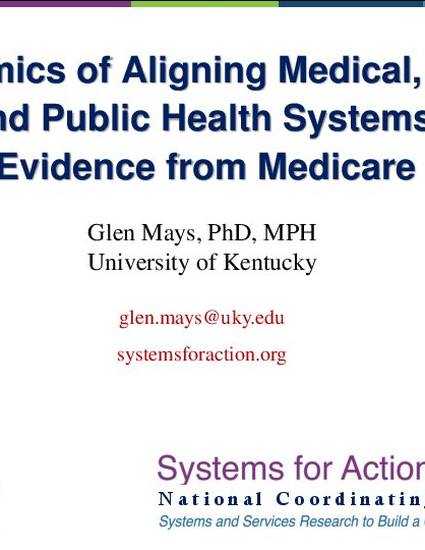
Presentation
The Economics of Aligning Medical, Social and Public Health Systems: Evidence from Medicare
American Public Health Association Annual Meeting
(2018)
Abstract
OBJECTIVES: Social, economic, and environmental conditions strongly influence health status for individuals and communities. Unfortunately, the services designed to improve these conditions – such as housing, transportation, nutrition, and economic assistance – are often disconnected from the medical services and public health programs tasked with improving health. Efforts to better align the delivery of medical, social, and public health services are likely to be particularly beneficial for older populations such as Medicare beneficiaries, given that health and social risks accumulate over the lifespan. This study follows a nationally representative cohort of U.S. communities to estimate how alliances among medical, social, and public health organizations influence Medicare spending over time. METHODS: Our retrospective cohort design follows more than 350 U.S. metropolitan communities over time using survey data collected over an 18 year span from 1998 through 2016. Each year local public health officials report on the implementation of 20 nationally-recommended health improvement activities in the community, and on the organizations that contribute to performing each activity including hospitals, primary care providers, insurers, employers, schools, social and community-based organizations. We classify communities into one of seven categories of multi-sector health activities based on a cluster analysis of the scope of recommended activities contributed by each type of organization, along with the density of relationships connecting these organizations. We link these survey data with and area-level measures of Medicare spending per beneficiary, along with measures of community demographic, socioeconomic, and health resource characteristics from other data sources. Random-effects models with instrumental-variables are used to estimate whether changes in multi-sector health activities lead to changes in Medicare spending, while controlling for both observable and unmeasured confounders. RESULTS: Communities with higher density of multi-sector health activities experienced significantly lower levels of medical care spending as measured by adjusted Medicare expenditures per person, particularly when instrumental variables-analysis is used to adjust for unobserved heterogeneity that jointly influence multi-sector activity and medical care spending. Communities achieving the highest density of activity experienced Medicare spending levels significantly lower than communities with the lowest density of activity (p<0.01) , after controlling for other factors. CONCLUSIONS: Incentivizing multi-sector health activities provides an effective way of containing medical costs for Medicare, alongside the gains in health status shown in prior studies. Medical providers operating under Medicare’s alternative delivery and financing system models, such as accountable care organizations and value-based payments, should seek to strengthen relationships with social and public health organizations.
Disciplines
Publication Date
Fall November 12, 2018
Location
San Diego, CA
Citation Information
Glen P. Mays. "The Economics of Aligning Medical, Social and Public Health Systems: Evidence from Medicare" American Public Health Association Annual Meeting (2018) Available at: http://works.bepress.com/glen_mays/338/
